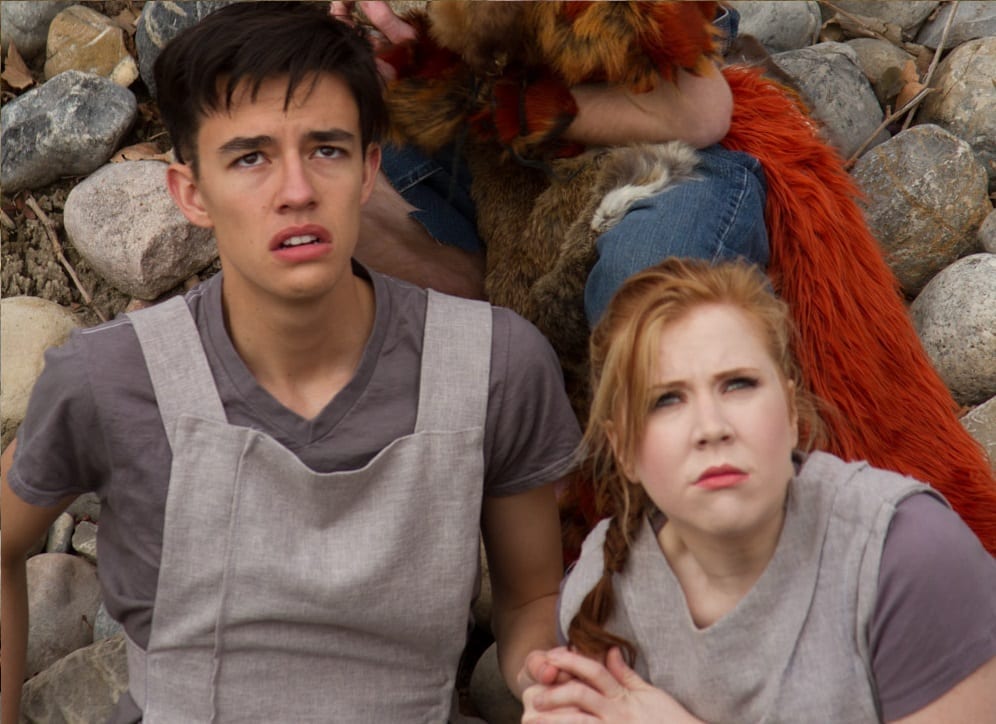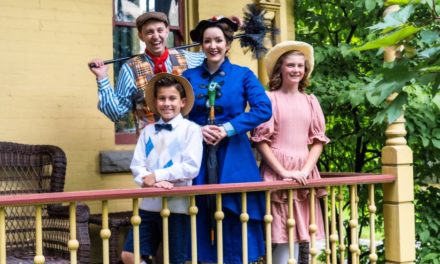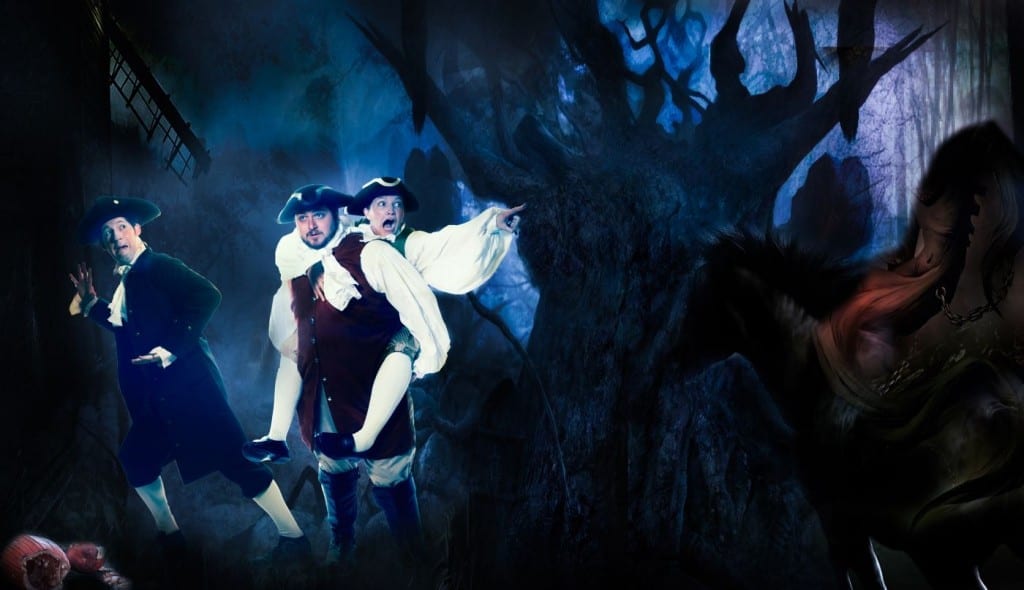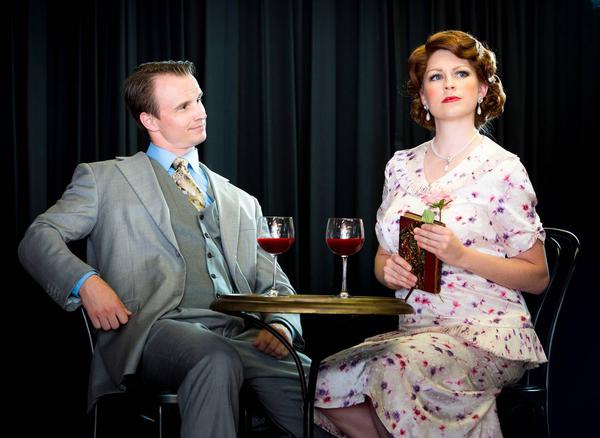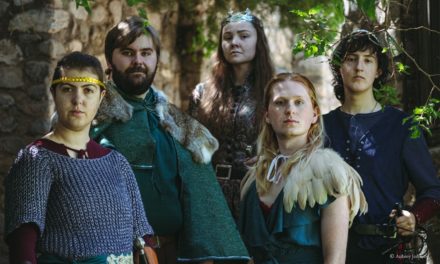OREM — In a “land of no past and no future,” all the people do what they are told and work together in harmony. There is no sickness, no disorder, and no death. It all seems perfect, until two children leave the community to search for something more. The world premiere of Suzan Zeder‘s The Milk Dragon tells the story of these two intrepid young people who embark on a journey to learn more about the world.
The first twenty minutes of Zeder’s script is a second-rate rehash of The Giver as the children live in a perfectly planned society and people have forgotten about hunger, death, and suffering. The principal character even sees colors, when others cannot. After leaving the town, the show takes on an Alice in Wonderland feel as the characters enter a bewildering fantasy world with its own rules and playful language. Unfortunately, the whimsy of Lewis Carroll is lacking in this world as the characters plod from location to location meeting characters like a wizard, a lost and found lady, a footnote, a wolf boy, and more.
Zeder’s script touches upon many important ideas: the damaging effects of censorship, the power of language and stories, the dangers of ignorance, the importance of art, overcoming fear, and feelings of loss. The problem with The Milk Dragon is that there are too many ideas. By focusing on so many messages, none of them are sufficiently strong to make an impact. Moreover, each additional “big idea” in the script makes the the story less and less accessible to its target audience of children. This inaccessibility was compounded by the decision to have one of the main child characters, Abra, quote William Shakespeare and George Bernard Shaw. No child in the world would be able to relate to Abra.

Top: Ryan Hopkins as Max. Bottom left: Brennan Newkirk as Zack. Bottom right: Briana Lindsay as Abra.
Perhaps it’s because of the big ideas in the script that the production works as well as it does. The director, John Newman, clearly believes in this story. Newman uses every directorial trick in his repertoire to sell this story to the audience. The pacing moves quickly from scene to scene, and Newman also excels in communicating the feelings and tone that are appropriate for each scene, such as the tender moment when Abra receives words of comfort from the wizard and the footnote.
The actors, too, work hard to make this problematic script work. Brennan Newkirk conveys the innocence of Zack’s youth and upbringing as he encounters death, anguish, and freedom for the first time. Newkirk is also effective in portraying Zack’s sense of wonder at the world when he discovers that it was so much more varied and exciting than he had imagined. As Abra, Briana Lindsay had a sweetness about her, especially in her encounters with the broken wizard and in the second act. The problem with these two main characters, though, is that for the first half of the play much of what they do is constantly asking questions. As time passed I began to feel like I was stuck in a car with an annoying child who incessantly asks why the sky is blue, why people drive on the right side of the road, why airplanes stay in the air, et cetera. Zack and Abra are very flat characters, and neither of them ever takes on enough reality and depth to make me ever care about them. None of this is Newkirk or Lindsay’s fault, though. This is just another product of a playwright more was concerned with ideas than other aspects of the play.
Tyrell Clement and Jessie Lynn Pusey (as the wizard and the footnote, respectively) inject some energy and humor into the meandering story. Their first appearance was a welcomed change from the dreariness of the town, and Pusey was best at maintaining a level of quirkiness of the play’s setting. Allyson Mitchell created the best performance among the supporting cast with her role of Magda, an eccentric who had a passion for dramatic literature. Mitchell’s mystical accent was perfect for her character, and I enjoyed the way she showed Magda’s love for the written word.
The only weak link among the cast was Ryan Hopkins in the role of Max, a wolf-boy. Hopkins had the appropriate physicality and body language for the role, but his voice seemed stiff and unemotional. I had the impression that Max should have been a cool sidekick character (sort of a cross between the Artful Dodger and a lost boy), but Hopkins’s acting choices didn’t show the dynamic charisma that such a character would need.
Along with the cast and director, the technical crew did their best to make the production work. Set designer Brian Healy created a symmetical set that exemplified the uniformity of Zack and Abra’s town. I also appreciated the many ways that the actors could enter and exit (including a conveyor belt-like rotating section). Jennesa Law-Fulton designed the costumes and “junkyard” animal puppets. Law-Fulton used color to show the mundane life of the townsfolk, the eccentric characteristics of the wizard, and Max’s savage nature. Her puppets were also extremely creative in the way that she took everyday objects to create animals on stage.
The cast and crew of The Milk Dragon give the show their best effort, and the production amply demonstrates the unique work that can only be found at Utah Valley University. However, the script is a muddled meandering mess of a story, and the hard work of these creative artists is unable to overcome the flaws in the written word.

